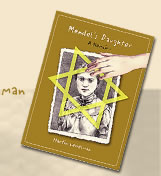

|
Q. You give credit to your mother on the title page. How long have you wanted to share her remarkable story? How did she feel about your desire to tell her story to the rest of the world? A. My mother never knew I would create a written record of her survival. What she wanted, more importantly, was that I pass on her story to my children. When I began Mendel's Daughter that was also my motivation. My goal was not to have her story published, but to create a clear and logical record of her journey that my children would want to read. I think she would be flabbergasted if she knew that her story would be read by strangers. "Feh, who would want to hear about such things," I can hear her say. Q. You mention in your biography that your mother didn't talk about her experiences openly. Why do you think she coped in this way? Once she began to share, did the stories come flooding out? A. That's a great question. While I was growing up, there was more "yelling than telling". Although my mother did tell my brother, Bernard, and me some stories about the Holocaust, she was more concerned that her children survive. And, of course, for Gusta eating equaled survival. While growing up "Eat, eat, eat!" was her constant refrain. "No, no, no!" was my usual answer. I also remember my mother always being nervous. She used the expression "mein kerper zeit, my body boils." However, in 1989, the year I recorded her story, she was more tranquil. I believe time and space made it easier for her to talk about the past. Once she began to talk, thankfully, she didn't want to stop. As far back as I can remember my mother lit memorial candles for her family. 1989 was the first time I saw her cry for her loss. Q. Can you tell us about the experience of hearing your mother's story for the first time? Did you have any idea about the details of her incredible survival? A. While I've always known that my mother survived the Holocaust, she rarely spoke about it. The story on pages 75-79 was one she told a number of times. It was because of my familiarity with this story, of her beating by the Nazi soldier and the escape of her brother Isia, that I illustrated it first. She also spoke a little about her experiences hiding in the forest with her sister and two brothers. It wasn't until 1989 that I truly understood the miracle of her survival. When I returned to the tape in 2003, I cried. Q. You open your book with a Yiddish saying: "Der Mentsch tracht, un Gutt lacht./Man plans, and God laughs." How did you choose this as an epigraph? Why is it fitting to open your mother's story? A. My grandfather Menachem Mendel was a good man. The Jews and Gentiles of Germakivka respected him. He owned a house, fields, a business and provided for his family. He loved his children and expected to be part of their future (p. 28). Then... Was there any person that could believe in 1942 that Hitler will come up and make gas chambers and burn people? (p. 93) "Der Mentsch tracht, un Gutt lacht. /Man plans, and God laughs." Q. What was it like to grow up the son of Holocaust survivors? How did it affect your understanding of the war and your own religious heritage? A. It wasn't easy growing up with survivor parents. I think my "toe story" best illustrates the Lemelman parent/child relationship. When I was five years old, I attempted to move a heavy metal pretzel box in our "living room" located in back of my father's candy store. I picked it up and almost instantaneously dropped it directly on the big toe of my left foot. An excruciating pain shot through me. I wanted to yell but I knew I couldn't. Even at that early age I knew that if I screamed, my mother would become hysterical. At that very moment, I knew instinctively that I didn't have enough energy to endure the pain in my toe and assure my mother that I was going to be OK. I told my brother instead. "Soak it in warm water if you want it to get better," an eight year old, Doctor Bernard, advised me. And that's just what I did. My sense of what it meant to be Jewish also developed early on. For me being Jewish was about being part of a group of strong, determined and creative people with a shared history. God and I, however, always have had a love/hate relationship. It bothers me when I read the prayers about God always rewarding the righteous and punishing evil. There is a Yiddish song attributed to the 19th century Chassidic Rabbi Levi Yitzchok from Berditchev called "A Din Torah Mit Gut, A Lawsuit with God". It begins — " Good morning, God. I, Rabbi Levi Yitzchok, the son of Sarah from Berditchev have come to take you to court. What do you have against your nation Israel? Why do you always crush your nation Israel?..." I've always identified with that song. In fact it was the inspiration of one of my earliest paintings. Q. The writing process must have been extremely difficult at times. What was the hardest to depict? What brought you the most joy? A. I see myself more as the editor than the writer of Mendel's Daughter. What was challenging for me was creating a clear and sequential story while retaining the unique flavor of my mother's speech patterns. I would have loved to have illustrated her story solely using the transcript of my interviews with her. Unfortunately my mother liked telling a story "her way." That is, as she spoke about life in 1939, her train of thought changed suddenly, and she seamlessly jumped 20 years into the future. This happened quite frequently. "Please Ma, let's go back to 1939," I pleaded. "Sure, sure, in ah minute," my mother said. I especially loved the stories about her life before the war. I enjoyed the flampletzles and the fluden - "A small piece you get, not more." (p. 17) It was emotionally difficult to write about Gusta's return to Germakivka after the war. Her treatment as a stranger in her own home and her reaction was hard to get just right. Q. You've been a professional illustrator for many years. Is this the most personal work you've done? How did that affect your drawing? Did your style change at all? A. Mendel's Daughter is quite different from anything else I've done. It is my most personal work. I wanted my art to match the simplicity of the words. It was with this in mind that I started to create preliminary drawings for the book. I spent the month of August 2003 experimenting with different styles and techniques. I worked with stylized scratchboard and ink, and realistic watercolor wash. I tried using traditional comic word balloons to hold the dialog. I threw them all in the trash. It was only after completing the pencil and ink drawing you see on page 3 that I knew I found the right technique for the book. Q. Your use of real photos, documents, and other artifacts is wonderful and adds great weight to the visual impact of the book. Why did you opt for a multimedia approach? How many more of these artifacts survived the war, or did you use all of what you have? How did you decide what to include? A. For me inspiration usually comes, more often than not, at unexpected times and in unusual ways. The decision to use photos, documents, and artifacts came from a $1.00 scrapbook I bought at a garage sale. The pages of this scrapbook were yellowed and crumbling. Glued to the disintegrating pages, however, were pristine photographs and ephemera of one woman's record of her engagement, wedding and honeymoon. As I turned the pages the photographs, postcards, newspaper clippings and receipts created a powerful and poignant visual narrative. I wanted readers of Mendel's Daughter to get the same emotional reaction. I want readers to understand that what happened in Mendel's Daughter happened to real people. I used most of the photographs and artifacts my mother left me. I wanted the book to be as complete a record of her experiences as possible. Q. When your mother names Hitler for the only time in the book, she follows with: "yemach shimo, his name should be erased (p. 53)." Please explain this saying. A. Yemach shimo is a Hebrew expression reserved only for people that are so thoroughly evil, they have no possibility of redemption. They should be erased, forgotten. It should be as if they had never existed. It is also for this reason I use his name only once in Mendel's Daughter. |

